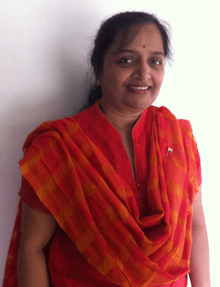Anuradha TK
Anuradha T.K. is a retired Indian scientist and project director of the Indian Space Research Organisation (ISRO), specialized communication satellites. She has worked on the launches of the satellites GSAT-12 and GSAT-10. She is the senior most female scientist at ISRO, having joined the space agency in 1982,[1][2] and also the first woman to become a satellite project director at ISRO.[3]
Anuradha T.K. | |
|---|---|
 | |
| Born | 30 April 1960 Bangalore, Mysore State, India |
| Nationality | Indian |
| Alma mater | University Visvesvaraya College of Engineering |
| Scientific career | |
| Institutions | Indian Space Research Organisation (ISRO) |
Biography
Anuradha TK was born in Bangalore, Mysore State (now Karnataka) in 1960.[4] She graduated with a bachelor's degree in electronics from the University Visvesvaraya College of Engineering in Bangalore.[5] Unlike many of her classmates, she chose to stay in India to pursue her career.[4]
Career
Anuradha TK is a Distinguished Scientist working as Director SATCOM, who was earlier Indian Geosat Programme Director at ISRO Satellite Centre. She works in the area of geo-synchronous satellites, which are crucial to telecom and data links.[6] She has been a leading figure in several Indian space programs.[7][8]
Anuradha's role was instrumental in developing and launching the ISRO communication satellite GSAT-12 satellite into space from the Satish Dhawan Space Centre on 15 July 2011.[9][10][11] She supervised and headed the technical group of 20 engineers.[7] As a part of an all-women research team, together with Pramoda Hedge and Anuradha Prakash, she manoeuvered the GSAT-12 into its final orbit from ISRO's Master Control Facility (MCF) in Hassan.[1][2][10][11]
After working with the GSAT-12, Anuradha TK led the launch of the much bigger communication satellite GSAT-10 in September 2012.[11][4]
As the project director, she also oversaw the launch of the GSAT-9, GSAT-17 and GSAT-18 communication satellites. She has also served as Project Manager, Deputy Project Director and Associate Project Director for the Indian Remote Sensing and the Indian Regional Navigation Satellite System programs.[2][5] Her specialty is satellite checkout systems which observe a satellite's performance once it is in space.[12]
Awards
- 2003 Space Gold Medal award by Astronautical Society of India for the services in the field of Space sciences
- 2011 Suman Sharma Award by National Design and Research Forum (NDRF) of IEI
- 2012 ASI- ISRO Merit Award for Realisation of Indigenous Communication spacecraft
- 2012 ISRO Team Award 2012 for being team leader for the realisation of GSAT-12[7]
References
- "The women scientists who took India into space". BBC News. 12 December 2016. Retrieved 4 March 2017.
- "Meet ISRO's 'Space Girls'". Deccan Herald. Retrieved 4 March 2017.
- info@biharprabha.com, Bihar Reporter. "Meet the lady behind success of RISAT I". The Biharprabha News. Retrieved 4 April 2017.
- ISS. "Reaching out to the skies". indianspacestation.com. Archived from the original on 2 July 2017. Retrieved 4 March 2017.
- "T K ANURADHA". 21 February 2014. Archived from the original on 21 February 2014. Retrieved 4 April 2017.CS1 maint: BOT: original-url status unknown (link)
- "India's rocket women". Deccan Herald. 26 February 2017. Retrieved 4 March 2017.
- "Smt T K Anuradha – IEEE WIE Global Summit 2016". wiesummit.ieeer10.org. Retrieved 4 March 2017.
- "Hands that rock the space missions at ISRO". The Week. Retrieved 12 March 2019.
- "ISRO successfully launches latest communication satellite GSAT-12". The Economic Times. Retrieved 4 April 2017.
- Martin, Max (23 July 2011). "ISRO banks on womanpower for GSAT-12". India Today. Retrieved 30 May 2018.
- "Only the sky is the limit". www.mea.gov.in. Retrieved 4 March 2017.
- "Woman's hand in India's latest satellite". Sify. Retrieved 4 April 2017.